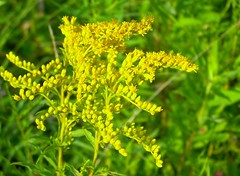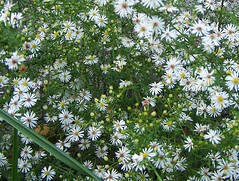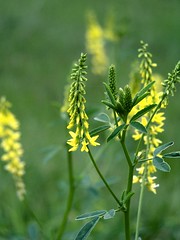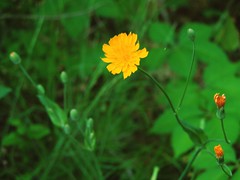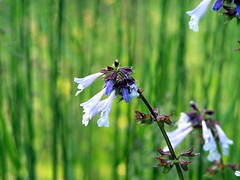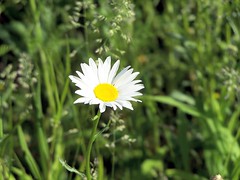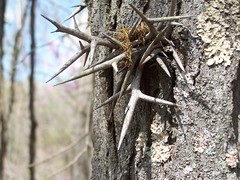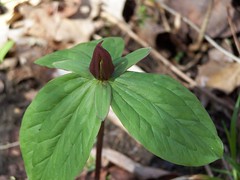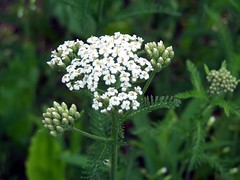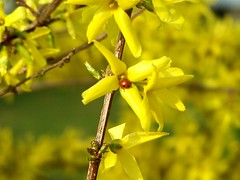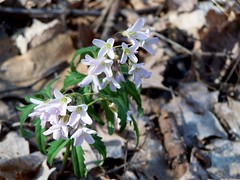One of the many species of goldenrod. This blooms in late summer - July-September-ish. Although allergies acting up are often blamed on goldenrod, I have it on good authority (wikipedia) that it is not goldenrod pollen causing bad allergies in the late summertime, but more likely Ragweed.
And now you know.
Monday, September 29, 2008
Thursday, September 25, 2008
Small White Wood Aster
Or possibly Calico Aster? I'd say definitely in the Aster family. Maybe.
This blooms in the fall and apparently profusely so. What a glorious bouquet!
This blooms in the fall and apparently profusely so. What a glorious bouquet!
Monday, September 22, 2008
Sassafras Tree
There are plenty of sassafras trees in these woods. The leaves come in about three shapes: There's the mitten-looking leaf shown here, the spear-shaped leaf and then the mitten-looking leaf with a "thumb" on both sides.
The roots of the sassafras can be dug up and boiled into an aromatic and fine-tasting tea. Unfortunately, ingested in too great amounts, the tea can be carcinogenic, according to recent studies.
However, it is my understanding that once or so a year is not enough to warrant concern.
The roots of the sassafras can be dug up and boiled into an aromatic and fine-tasting tea. Unfortunately, ingested in too great amounts, the tea can be carcinogenic, according to recent studies.
However, it is my understanding that once or so a year is not enough to warrant concern.
Monday, September 8, 2008
Mistflower
The Mist flower is an attractive late season perennial about 3 feet tall with blue flowers. The Mist Flower is also known as Blue Bonnet or Wild Ageratum.
Blooms late summer.
Blooms late summer.
Tall Ironweed
From one source, tall ironweed...
May be a noxious weed or invasive
This plant is attractive to bees, butterflies and/or birds
Self-sows freely; deadhead if you do not want volunteer seedlings next season
This plant is resistant to deer
Blooms late summer.
May be a noxious weed or invasive
This plant is attractive to bees, butterflies and/or birds
Self-sows freely; deadhead if you do not want volunteer seedlings next season
This plant is resistant to deer
Blooms late summer.
Friday, June 20, 2008
Chicory
I've not spotted chicory on the farm yet, but it is an everpresent reality in our part of the world, so I shouldn't be surprised were it to be present there somewhere.
Along with Queen Anne's Lace, Chicory is a frequent roadside weed growing everywhere along highways and in empty urban lots. Some use its roots to make a coffee, or so I'm told.
Chicory blooms its brilliant blue flowers from Mid-May through summer.
Along with Queen Anne's Lace, Chicory is a frequent roadside weed growing everywhere along highways and in empty urban lots. Some use its roots to make a coffee, or so I'm told.
Chicory blooms its brilliant blue flowers from Mid-May through summer.
Tuesday, June 17, 2008
Queen Anne's Lace
I have not spotted Queen Anne's Lace at the farm yet, but it is quite plentiful in the region. This plant (also known as Wild Carrot, as its young root is edible - in the carrot family) is often seen on roadsides beginning in late May in our region, along with the ubiquitous Chicory.
While this is an edible wild plant, extreme caution should always be exercised when eating food you're not sure of. And especially in this case, as Queen Anne's Lace looks quite similar to the deadly poisonous Hemlock.
Once the flower is finished blooming, it folds in upon itself, looking very much like a beautiful birds nest, which explains the common British name of the flower - Birds Nest.
While this is an edible wild plant, extreme caution should always be exercised when eating food you're not sure of. And especially in this case, as Queen Anne's Lace looks quite similar to the deadly poisonous Hemlock.
Once the flower is finished blooming, it folds in upon itself, looking very much like a beautiful birds nest, which explains the common British name of the flower - Birds Nest.
Thursday, June 5, 2008
Garlic Mustard
This is an invasive transplant from Europe. The Garlic Mustard grows throughout the eastern US and blooms in mid-May.
It gets its name from the fact that its crushed leaves smell garlic-y (and, therefore, keeps the bugs away).
Also called Jack-by-the-hedge.
It gets its name from the fact that its crushed leaves smell garlic-y (and, therefore, keeps the bugs away).
Also called Jack-by-the-hedge.
Friday, May 23, 2008
Sweet Yellow Clover
I don't believe this has been spotted at the farm, but this photo is from these parts, so it may be found on the farm eventually. A graceful spiky field flower which blooms around May and doesn't look much like its lowly white and red clover cousins.
Monday, May 19, 2008
Black Locust Tree Bloom
Roger and I were looking at this tree's flowers trying to figure out what sort of tree it was. If we had followed the branch back to the tree, we would have seen the thorns on the trunk to suggest a locust tree. I believe this is a black locust, which I did not know bloomed such wonderful flowers.
Many of these trees surround the field at the farm. The flowers bloom in May.
Many of these trees surround the field at the farm. The flowers bloom in May.
Blackberry Bloom
The blackberry flowers out in May and that means that the fruit can't be too far away...
The farm is swimming in blackberry bushes (and their thorns).
What's the railroad to me?
I never go to see
Where it ends.
It fills a few hollows,
And makes banks for the swallows,
It sets the sand a-blowing,
And the blackberries a-growing...
~Henry David Thoreau
The farm is swimming in blackberry bushes (and their thorns).
What's the railroad to me?
I never go to see
Where it ends.
It fills a few hollows,
And makes banks for the swallows,
It sets the sand a-blowing,
And the blackberries a-growing...
~Henry David Thoreau
Dwarf Orange Dandelion (Two-flowered Cynthia)
I had trouble finding one of these with the petals open, I guess they open in the morning. But I could tell it was a bright orange splash of color in the field even from the folded flowers.
If I'm not mistaken, this is the Dwarf Orange Dandelion, also called the Two-flowered Cynthia. Blooms in May.
If I'm not mistaken, this is the Dwarf Orange Dandelion, also called the Two-flowered Cynthia. Blooms in May.
Lyre-leaved Sage
After doing a bit of research, I'm prepared to call this one a Lyre-leaved Sage. Blooming profusely in the field in mid-May.
Daisy
I'm pretty sure this is a daisy, I just don't know what type. Ox-eye? Western? Other?
Anyone know?
Blooming beautifully in the farm field in mid-May.
Anyone know?
Blooming beautifully in the farm field in mid-May.
Friday, May 16, 2008
Redbud
There's at least one redbud tree down in the creek near the bridge, but there's probably others. The redbud (which tends more towards the purplish-pink, if you ask me) is interesting in the way its flowers bloom right off the trunk (as seen in this photo) as well as on the branches.
Honey Locust Tree
Be careful if you go to climb a honey locust tree. These thorns are hard as nails and as sharp. (I'm told they used to be actually used as nails once upon a time!)
Trillium
The Trillium is one of the early blooming wildflowers in this area. As the name suggests, the flower often has three petals (different colors, depending on the species) and three leaves, as seen in this picture.
Usually, in these parts, I believe you'd expect to see mostly white or maroon flowers. Correct me if I'm wrong.
Usually, in these parts, I believe you'd expect to see mostly white or maroon flowers. Correct me if I'm wrong.
Wednesday, May 14, 2008
Clover
Sweet, sweet clover.
Ubiqitous, usually three-leafed (but keep an eye out for that special four-leaf clover!) and easily found, clover comes in many varieties, but the type pictured is perhaps the most common one found on the farm (although there's also red clover, with a slightly larger flower that is purplish-red in color).
Wendell Berry has this to say about clover...
In the dark of the moon, in flying
snow, in the dead of winter,
war spreading, families dying, the
world in danger,
I walk the rocky hillside, sowing
clover.
Ubiqitous, usually three-leafed (but keep an eye out for that special four-leaf clover!) and easily found, clover comes in many varieties, but the type pictured is perhaps the most common one found on the farm (although there's also red clover, with a slightly larger flower that is purplish-red in color).
Wendell Berry has this to say about clover...
In the dark of the moon, in flying
snow, in the dead of winter,
war spreading, families dying, the
world in danger,
I walk the rocky hillside, sowing
clover.
Tuesday, May 13, 2008
Yarrow
This plant is frequently found in grasslands and open forests and has been seen blooming in the farm field beginning in late April. It has beautiful, fern-like leaves and a broad cluster of white flowers.
Wednesday, April 30, 2008
Cutleaf Toothwort
Blooms in March to April. Commonly found in the woods and along woodland paths. Usually just about the first wildflower I commonly spot. Maybe even in February.
Subscribe to:
Posts (Atom)
